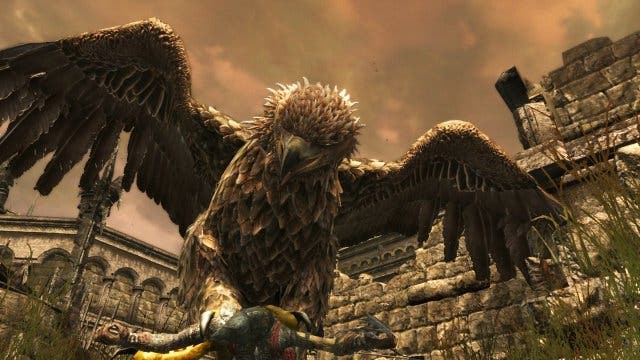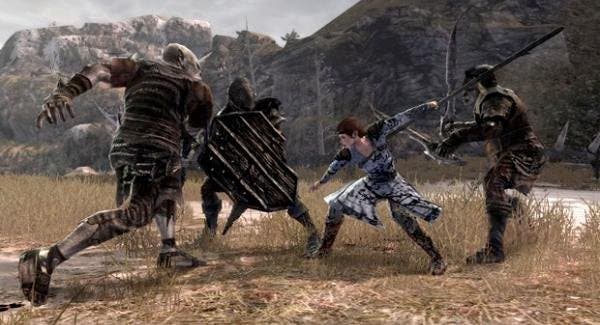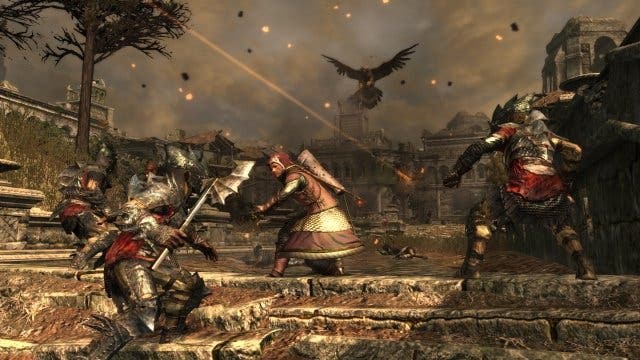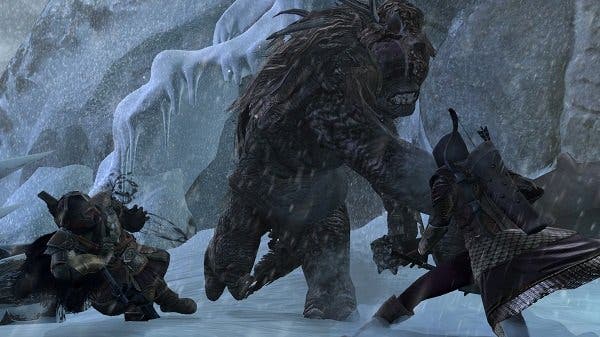The Lord of the Rings: War in the North Review
Bored of the rings.
Releasing a high-fantasy game a scant couple of weeks after Skyrim (in Europe) may be as foolhardy as entrusting a hobbit to hurl an all-powerful ring into a volcano, but everyone likes an underdog. While I'd love to tell you that The Lord of the Rings: War in the North succeeds against the overwhelming odds of being a second-tier licensed game clashing against Bethesda's behemoth, the truth is that it's as gruelling as Frodo's journey, yet retains none of the satisfaction, wonder or excitement of its source material.
Unwilling to step on any literary toes, War in the North follows the story of three unsung heroes whose journey runs parallel to the fellowship we've all come to know. While this provides an ample excuse to explore Middle Earth, one can't shake the feeling that the game takes place in alternate dimension full of less interesting personalities.
You play as a trio - a human, an elf and a dwarf - but they lack the charisma of their counterparts Aragorn, Legolas, and Gimli. There's a giant female spider, but she's not the infamous Shelob; and the central villain, a high-ranking lieutenant of Sauron, seems awfully important for someone who's never been mentioned before. War in the North may crib Tolkien's genre-defining universe, but outside of a few cameos by awkwardly voiced, well-known characters, it has little to do with the series proper.

The story is merely a catalyst for a linear dungeon crawler with an emphasis on co-op. Each character has their own skill tree and unique powers. Andriel, the elven lore-master, can cast a large sphere that heals those standing inside it while providing protection from ranged attacks; Eradan, the human ranger, can dual-wield weapons; and Farin, the dwarf champion, specialises in all manner of melee attacks. You can swap characters between stages and your level remains consistent across the board, so if you decide that being a lore-master isn't for you, then you can switch to a ranger and assign all the skill points you would have acquired had you been a ranger all along.
For the first few hours, slashing through hordes of orcs feels satisfying. Attacks convey a strong sense of brutality, with gruesome slow-mo animations fetishizing amputations every time you score a critical hit. Smartly, critical hits are context-sensitive, occurring when you use a strong attack as a yellow triangle appears over an enemy's head. Ranged combat is handled with a zoomed-in, over-the-shoulder camera and switching between perspectives is swift and effortless.

New abilities and useful loot are frequently doled out and varied set-pieces require switching between melee and ranged combat, manning turrets that shoot explosive arrows, and blowing up snipers placed conspicuously next to the oldest of game clichés: explosive red containers. It's nothing you haven't seen before, but the steady drip of new gear mirrors Lord of the Ring's themes of greed and compulsion. Though unlike the ring that drove Sméagol to murder Déagol, there's loot enough for all and much of it is dictated by class, so there's no need to fight.
While it starts off entertaining, things quickly take a turn for the tedious. As the game goes on, enemies start taking loads of damage, making your massive hammer feel no more powerful than a wispy twig. Something is certainly wrong in the state of Mordor when a lowly sniper takes 10 arrows to kill. The opposition's numbers increase so drastically that your feeble block and dodge manoeuvres aren't up to task.
Bewilderingly, your special moves are given short shrift by a dismal system that discourages their use. They're on a cooldown timer, which seems sensible, but also require willpower, which regenerates incredibly slowly. Such powers had the capacity to add depth to battles, but since their cost is so high you'll spend most of your time mashing the basic attack buttons. Even when you do get a chance to use these abilities, they're not that much more powerful than standard attacks. It's like your twig occasionally upgrades to a ruler.

In later stages, the resolutely reviving AI goes from being a boon to a curse, when your resurrection becomes their sole priority. They'll often stand next to your gasping avatar getting knocked about by cave trolls without bothering to defend themselves. AI and players alike frequently get boxed into corners, all too easy due to terrible collision detection where characters occupy far more space than they appear to. It's often up to luck whether your AI companions will save you or kick the bucket regardless of your performance up to that point, making War in the North a dreadful single-player experience.
Playing with real people helps, but even this has issues. Unless you're playing with someone at approximately the same level, War in the North will be way too easy or way too hard. Whoever has the higher level will end up doing most of the killing and gain more experience, making it even more unbalanced for the weaker players. Reviving prompts are also finicky, leading to some aggravating failed rescues.
Outside of combat, War in the North's hub areas are filled with lifeless characters and a dialogue system that apes Mass Effect, only without any actual choices. Beginning the game, I was greeted by a man who wanted me to help him court his crush. Since I had a world to save (or rather assist in saving, since Frodo and co. are off doing the more exciting work), I told him to bugger off. Upon talking to him again, he reintroduced himself as if the conversation hadn't just happened. A simple "Have you changed your mind?" would have sufficed.

Elsewhere, the obligatory giant spider boss is far from the biggest bug in the game: War in the North is a glitchy mess. A few hours in, I hit a game-breaking glitch: upon beating a stage, the next area failed to unlock. Replaying a prior level in the hope of circumventing it, I encountered a different game-ending glitch where a cut-scene failed to trigger, leaving my party unable to progress. Reloading multiple times didn't help and after a few curse words and a headache, I had no choice but to restart from scratch. While researching a fix, I discovered that there are several known glitches that can render it impossible to beat the game, which is frankly unacceptable. [Editor's note: Jeffrey wasn't even reviewing a pre-release version of the game, but the North American edition which has been on sale since 1st November.]
The Lord of the Rings: War in the North is a soulless cash-in that has little to do with its license, and nor is it much fun in its own right. If you're lucky enough to not encounter any game-breaking bugs and if you have a friend or two to play with, then it can be pretty entertaining for a few hours. But that's a lot of "ifs" for so little payoff, since overlong levels and axe-sponge enemies inevitably whittle this dungeon crawl down into a slog. Repetitive, dull, buggy and frustrating, The Lord of the Rings: War in the North turns visiting one of Western civilisation's most revered fictional settings into a chore.










